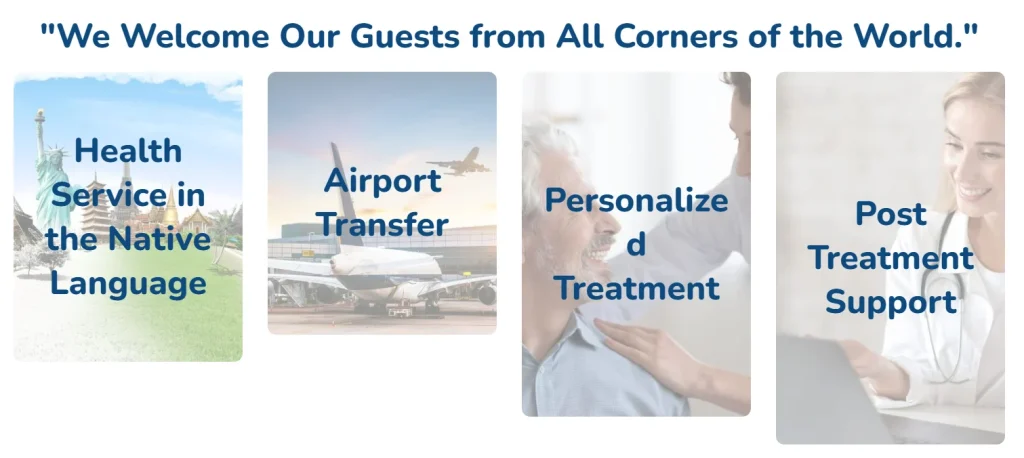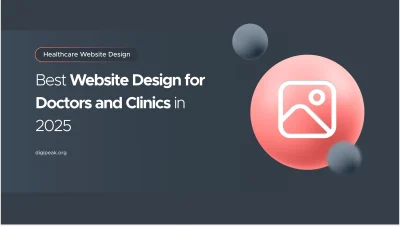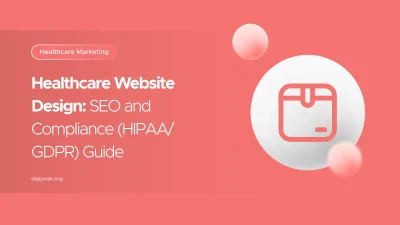
B2B Healthcare Marketing: Viable Medical Business Solutions
The healthcare sector is undergoing a profound digital transformation. For businesses operating in the B2B …
20/08/2025 -
12 dk okuma
Stay up to date with Peakers
Healthcare website design for an aesthetic clinic means blending beauty with functionality. Your site is often the first impression patients have of your brand, so it must instill trust, highlight expertise, and drive appointments. Start by defining clear goals and target audience: do you want more cosmetic consultations, new patient appointments, or telemedicine signups? Tailor the site’s content and user journey to those aims. Identify who your ideal patients are – for example, “busy professionals seeking lunch-hour Botox” or “expat families in the Gulf region wanting specialized dermatology care”. Understanding demographics and search intent guides everything from design to messaging.
Your branding must be consistent and aspirational. Research shows most search queries gravitate towards familiar names, so a strong clinic brand boosts visibility and trust. Define your unique identity (e.g. cutting-edge technology, holistic treatments, luxury spa atmosphere) and weave it into all marketing. Consistent logos, color palettes, and tone make your clinic memorable and credible. Build a professional online presence across platforms – not just your website, but Google Business listings, review profiles, and social media – to reinforce your brand name. Publishing high-quality, educational content (blogs on treatments, FAQs, patient guides) will position your clinic as an expert authority. Strong brands draw loyal customers and new patients alike, so invest time in branding even as you plan the site.
Low Consultation / Appointment Rates?
Increase Bookings with a Free Funnel Review.
We’ll identify drop-off points from click to consultation and recommend fixes that actually convert. Request your free review.
Aesthetic clinic websites should feel modern and welcoming, yet intuitively guide visitors to key actions (like booking a consultation). Begin with responsive, secure pages: over 50% of healthcare searches happen on mobile devices, so ensure your layout adapts cleanly to any screen. Use HTTPS for all pages to protect user data and build trust. Choose a fast, reliable hosting and streamline your code – every second of load time can lose patients. For example, studies show users visit almost three times more pages when a site loads in 2 seconds versus 8 seconds. Compress images (clinic photos, before/afters) and leverage caching to boost speed.
Prioritize user experience (UX) at every step. Create an easy-to-follow site map with clear menu labels (e.g. “Treatments,” “Our Team,” “Book Now”) so visitors can instantly find what they need. Every page should have a clear call-to-action (CTA) button – for example, “Request a Consultation,” “See Results,” or “Download Our Cosmetic Guide” – consistently styled in your accent color. Break text into digestible chunks with headings, bullet lists, and high-quality visuals. Use professional photos of your clinic and staff to humanize the brand. For instance, a waiting room photo or treatment room shot can make the site feel real and trustworthy (see image below).
Use polished clinic interior images (like this modern therapy room) to create a calming, professional vibe. Websites should feature real photos of your space and team to build trust (not just stock images).
Integrate smart navigation and search. Use dropdowns or mega-menus for multiple service categories (e.g. “Injectables,” “Laser Treatments,” “Skincare”) so visitors can jump directly to their interest. Consider adding a site search box for larger sites. Always include a sticky header or footer with contact info (phone, email, address) and prominent “Book Appointment” links. Mobile visitors especially appreciate one-tap calls or booking links. For global or multi-location clinics (like those serving US, UK, or Gulf regions), include a location selector or clearly list all office addresses.
Don’t forget accessibility and compliance. Follow ADA guidelines by using readable fonts, proper color contrast, and alt-text for images. This is not just ethical – it’s often legally required for healthcare sites. Ensure forms are secure (use reCAPTCHA to avoid spam and protect patient data) and include HIPAA-compliant systems for any patient communication. Finally, a modern clinic site should support telehealth options: if you offer virtual consults, include a section explaining how it works and an easy “Telemedicine Visit” scheduler. Telehealth pages can attract a wider audience, especially in current times.
Having a great design is just step one; you need quality content to attract and retain patients. Craft a content strategy focusing on your patients’ questions and needs. Write blog posts, videos, or infographics explaining procedures (“What to Expect in a Botox Treatment”), skincare tips, or success stories. This content shows expertise and improves your search rankings. Search engines reward regularly updated, relevant content. For example, a dental clinic might publish “Top 5 Aftercare Tips for Veneers,” while a medspa might blog “How Laser Hair Removal Works”.
Optimize all content with clinic-specific keywords. Include “aesthetic clinic in [Your City]”, “cosmetic dermatologist UK”, or “best spa treatments UAE” throughout service pages and posts. Target long-tail queries like “non-surgical nose job near me” in PPC ads and SEO. Local SEO for clinics is crucial: list your clinic on Google My Business and ensure your NAP (name, address, phone) is consistent across directories. Consistent local info helps Google serve your site to high-intent local patients. Claim positive reviews on Google and health portals; then feature them on your site for social proof. Patients trust clinics with visible 4–5 star ratings and testimonials.
Maintain a fresh blog or news section. Google rewards sites that add new content. Even simple case studies or announcements (new doctor, award, technology) can boost SEO. Audit old posts annually to update any outdated medical info. Link out to authoritative sources (journals, guidelines) to increase credibility. For example, link to high-impact journals or professional associations when describing treatments. Incorporate content upgrades like free brochures or videos in exchange for email signups. (More on email in a bit.)
Paid advertising can rapidly boost your clinic’s visibility. Google Ads (Search and Display) and social media ads let you reach people actively seeking cosmetic or healthcare marketing services. PPC places your clinic at the top when someone searches “dermatologist near me” or “emergency dental implant”. Use targeted Google Ads campaigns for high-intent keywords: e.g. “Botox injections [City]” or “plastic surgeon consultation”. Include geo-targets (radius targeting around your clinics) to capture local patients. Paid search is highly measurable – you can track exactly how many calls or bookings each ad generates.
PPC for healthcare has some special rules. Avoid restricted terms (like “cure” or prescription names) that trigger automatic disapproval. Follow all advertising regulations (no misleading claims like “guaranteed results” without proof). If targeting cosmetic surgery audiences, consider remarketing carefully: Google no longer allows remarketing in many health verticals. Instead, compensate by maximizing your ad position and impression share so patients see your name consistently. Use all ad extensions: callouts (“Free Consult!”), sitelinks (“Before & After Gallery”), and structured snippets (list of treatments). These increase your ad real estate and click-through rate.

Don’t neglect paid social. Platforms like Instagram and Facebook are image-driven, ideal for aesthetic clinics. Run sponsored before/after photo campaigns or special offer ads to qualified demographics (e.g. women 30–50 in your service area). Facebook Lead Ads or Instagram “Book” buttons can directly capture appointment requests. LinkedIn Ads may even help recruit referring physicians or staff. Always test different creatives and copy to see what converts best.
In short, PPC management for healthcare means careful targeting, monitoring budgets, and compliance. A well-optimized PPC campaign provides immediate visibility, precise targeting (by location, device, time of day), and clear ROI tracking. It’s one of the fastest ways to generate new appointments compared to organic channels, so include it in your marketing mix.
Social media is essential for aesthetic clinics. Your social profiles (Instagram, Facebook, TikTok, Pinterest) act as a “digital storefront” that showcases your clinic’s personality and portfolio. Post consistently (even a few times per week) with a mix of content: educational tips (e.g. “5 Skincare Myths Debunked”), behind-the-scenes shots, and patient transformations (with permission). Authenticity wins – users prefer real stories over slick ads. For example, share a quick video of a nurse explaining how a facial works, or a “day in the life” story of your clinic manager. This builds trust: as one expert notes, “People want to book with someone they know, like, and trust.”
Always engage with followers. Social media is two-way – respond to comments, answer DMs, and run interactive polls or Q&A sessions. Ask questions like “What’s your biggest skincare concern?” and follow up with solutions. Encourage happy patients to tag you or post reviews. Use hashtags strategically (e.g. #AestheticClinic, #ItanbulBeauty, #SkincareTips) to increase reach in your region.

Consider influencer or community partnerships. Collaborate with local beauty bloggers or wellness events to co-promote. Host online webinars or IG Live chats on popular topics (like anti-aging or weight loss). These activities can grow your audience and position your clinic as a thought leader.
When it comes to building your team’s online presence, don’t forget the doctors and nurses. Feature staff introductions and personal stories on social channels. Physician marketing strategies might include brief “ask-me-anything” video sessions or LinkedIn articles by doctors discussing industry trends. This humanizes your clinic and leverages each team member’s credentials.
Email is a powerful tool to nurture and retain patients. Send regular newsletters with clinic news, promotions, and helpful content. For example, a quarterly email might announce a new laser machine, share a spring skincare routine, and offer a limited-time discount on injectables. Always segment your list by interests (e.g. skincare vs. dental) to send relevant content. Use clear subject lines (“Summer Smile Makeover Specials Inside!”) and a strong CTA (“Book Your Free Consult Now”).
Keep compliance in mind: U.S. and UK clinics must follow privacy laws like HIPAA/GDPR. This means obtaining explicit opt-in permission and providing easy unsubscribe options. Treat email addresses as confidential information (don’t sell or misuse them). Ideally, have patients check a marketing opt-in box during intake so you can email them legally. Use a HIPAA-compliant email platform if you’re sharing any protected health information.
Include emails in your broader marketing funnel. For instance, after someone downloads an e-book or requests a brochure via your site, automatically send a welcome series: 1) a thank-you with more info, 2) a follow-up on clinic highlights (like best-seller treatments), 3) an exclusive offer. Automated drip campaigns like this can turn leads into booked patients. Track email performance (open rates, click-throughs) and refine your content accordingly.
Telehealth has become a key service offering for modern clinics. If your aesthetic practice provides virtual consultations or follow-ups, your website must market this clearly. Create a “Virtual Consultations” page that explains the convenience and security of remote visits. Use keywords like “online dermatologist appointment” or “virtual botox consultation” to capture search traffic. Emphasize that telehealth lets patients get care from anywhere (important for overseas Gulf clients or home-bound seniors).
Optimize the site for telehealth queries: add FAQ sections about how to prepare for an online session, list telemedicine fees, and feature a direct link/button to request a virtual appointment. In your SEO strategy, target terms like “telehealth clinic [City]” and “telemedicine cosmetic surgeon”. Since many patients now prefer remote care, use content marketing (blogs, videos) to highlight its benefits. For example, a blog post could answer “What to Expect in a Virtual Skin Consultation” or “Top 5 Tips for a Successful Video Visit”.
In paid campaigns, allocate some budget to telehealth terms. Google and social PPC ads can specifically advertise virtual services with headlines like “Teledermatology Available – Book Online”. The goal is to raise awareness of your remote care options. Telehealth marketing differs from brick-and-mortar promotion: instead of showing building photos, emphasize convenience, accessibility, and technology.
Finally, integrate telehealth calls-to-action on your main site and social channels. For instance, on your homepage and in emails, include buttons such as “Schedule Virtual Visit” or “Ask a Nurse”. This way, traditional and virtual care are both easy to find and book.
Looking at real-world examples can spark ideas. For instance, the Istanbul-based SevenHillsDent site (a dental clinic) uses bold visuals and clear trust signals. They showcase their specialists with credentials and images, and prominently display metrics (“25,000+ smiling patients” and “12,000 successful operations”) on the homepage. Their site also features patient reviews and easy contact forms – all reinforcing credibility. Similarly, Moodist Hastanesi (a Turkish mental health hospital) lists its specialized centers (Adult Psychiatry, Child & Adolescent, Addiction, Neurology, etc.) right on the homepage, allowing patients to quickly understand services offered. They also provide downloadable brochures and articles (“Moodist Information Library”), demonstrating how clinics can offer educational resources to engage visitors.
Exemplary clinic exteriors or lobbies (like this medical center entrance) can be used on websites to set a professional tone. Such images, combined with clear navigation, help convey a high-end clinic experience.


Spa and Welfare websites often balance luxury with usability. For example, a top spa site uses a calming color scheme, large hero images, and persistent “Book Now” buttons to convert interest into bookings. They blend rich content (testimonials, blogs, before/after galleries) into an uncluttered layout so the site feels both informative and relaxing. Key takeaways from leading examples: use high-quality, custom imagery (show real patients or facilities), keep booking CTAs front-and-center, and maintain a clean, mobile-friendly design.
These examples illustrate the principles discussed: cohesive branding, mobile-first layouts, visible trust signals (reviews/certifications), and strong calls-to-action. As you plan your own site, remember that design trends will evolve, but fundamentals like clear navigation and genuine patient-centric content will always win.
Get an Offer


Join Us So You Don't
Miss Out on Digital Marketing News!
Join the Digipeak Newsletter.
Related Posts

The healthcare sector is undergoing a profound digital transformation. For businesses operating in the B2B …

As more patients turn to Google and smartphones for health information, a clinic’s website design …

Healthcare websites serve as a digital marketing front door for practices and hospitals, so they …

today’s competitive dental industry, a polished, optimized website is the cornerstone of attracting new patients. …